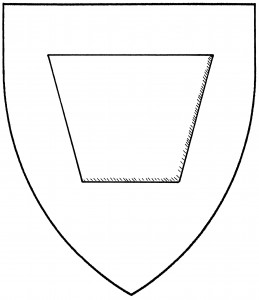A keystone is the central stone found at the top of an arch, which has the job of keeping the two halves of the arch from collapsing. Though the term was used in period, the keystone does not seem to have been a period heraldic charge. In Society armory, the keystone is defined to be trapezoidal, with the wide edge to chief; this appears to have been a common form in period architecture. This form is similar in shape (though inverted) to the “quoin”, a wedge-shaped cornerstone, as found in the canting arms (Portuguese cunha) of Cunha, c.1540 [Nobreza x].
A form of keystone frequently used in Society armory is a stylized modern form, one of the symbols of the state of Pennsylvania: a trapezoid with two notches in the upper corners. This form is considered a step from period practice.
The Order of the Keystone, of Æthelmearc, bears: Or, on a keystone gules an escarbuncle argent.
Jon Trimara bears: Per chevron vert and gules, in saltire an arrow inverted and a sword Or and in chief a dovetailed keystone gules, fimbriated Or.
Lysken die Waeyer bears: Vert, three keystones argent.
